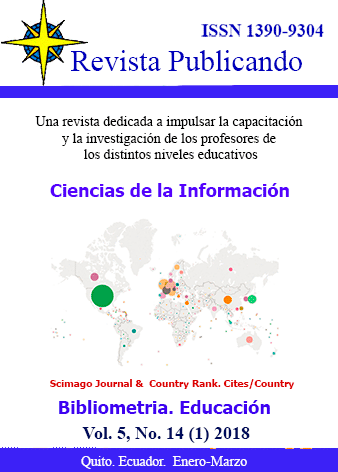Abstract
El objetivo principal de esta investigación fue determinar las tendencias investigativas que se han reportado para las investigaciones sobre redes de maestros. La investigación tomó como punto de partida una revisión bibliográfica en relación con el termino redes de maestros en Google Académico. La búsqueda se realizó tanto para la aparición de este término en el titulo como para su aparición en el resumen y palabras claves. Para precisar desde el punto de vista internacional el desarrollo de las investigaciones en la temática analizada, la búsqueda se realizó empleando Scopus, para el mismo término en idioma inglés “teacher networks” en el título de los artículos.
Se evidenció una brecha en relación con el número de trabajos reportados en idioma español y referidos a Latinoamérica y los publicados sobre el mismo tema en idioma inglés. Los trabajos en idioma español reportan experiencias particulares y no profundizan de forma crítica en los resultados alcanzados con las redes de maestros.
La determinación de las frecuencias de palabras claves de las 346 referencias reportadas en Scopus permitió determinar las tendencias más importantes de las investigaciones reportadas y que fueron las relacionadas con el papel de las redes de maestros en el desarrollo profesional de estos y la aplicación del análisis de redes sociales a este tipo particular de redes.
Como importante vacío en la literatura existente y que debe ser tomado en cuenta en futuras investigaciones apareció la necesidad de determinar las relaciones existentes entre los participantes en redes de maestros y el papel que estas pueden desempeñar en el desarrollo de maestro líderes.
References
Daly, A. J., Liou, Y.-H., et al.Moolenaar, N. M. (2014). The principal connection: Trust and innovative climate in a network of reform Trust and school life (pp. 285-311): Springer.
Daly, A. J., Moolenaar, N. M., Bolivar, J. M., et al.Burke, P. (2010). Relationships in reform: The role of teachers' social networks. Journal of Educational Administration, 48(3), 359-391.
Devaney, K. (1981). A network for dialogue: The teachers' centers exchange. Education and Urban Society, 13(4), 487-506. doi: 10.1177/001312458101300407
Ellison, N. B. (2007). Social network sites: Definition, history, and scholarship. Journal of computer”mediated Communication, 13(1), 210-230.
Garton, L., Haythornthwaite, C., et al.Wellman, B. (1997). Studying online social networks. Journal of computer”mediated Communication, 3(1), 0-0.
Granovetter, M. S. (1977). The strength of weak ties Social networks (pp. 347-367): Elsevier.
Harzing, A. W. (2008). Publish or perish.
Hounshell, P. B. (1985). The science education information network: A rapid response opportunity for teachers. Science Education, 69(2), 259-263. doi: 10.1002/sce.3730690217
Martínez, J. C., Gajardo, C. C., Tampier, R. D., Yancovic, M. P., et al.Montecinos, C. (2010). " Los maestros de la red de maestros de maestros: Una mirada crítica a sus contribuciones al desarrollo profesional de sus pares".
Moolenaar, N. M. (2012). A social network perspective on teacher collaboration in schools: Theory, methodology, and applications. American Journal of Education, 119(1), 7-39. doi: 10.1086/667715
Moolenaar, N. M., Sleegers, P. J., et al.Daly, A. J. (2012). Teaming up: Linking collaboration networks, collective efficacy, and student achievement. Teaching and Teacher Education, 28(2), 251-262.
Moolenaar, N. M., Sleegers, P. J. C., Karsten, S., et al.Daly, A. J. (2012). The social fabric of elementary schools: A network typology of social interaction among teachers. Educational Studies, 38(4), 355-371. doi: 10.1080/03055698.2011.643101
Moreno Sierra, D., Benavides Melo, J., & Muñoz Trujillo, C. . (2017). Iniciativas en educación ambiental como insumo para la constitución de la red de maestros en formación ambiental de la upn. Revista Bio-grafía Escritos sobre la biología y su enseñanza, 10(9), 1196-1203. doi: http://dx.doi.org/10.17227/bio-grafia.extra2017-7290
Rodríguez, C. Z. (2012). Red de maestros en educación ambiental: Un espacio de formación de formadores en bogotá, colombia. Nodos y Nudos, 4(32).
Rosenfield, S. (1980). Consultation in a teacher center: A network model. Journal of School Psychology, 18(1), 74-78. doi: 10.1016/0022-4405(80)90051-5
Scott, J. (2011). Social network analysis: Developments, advances, and prospects. Social Network Analysis and Mining, 1(1), 21-26.
Smith, P. S., Trygstad, P. J., et al.Hayes, M. L. (2018). Social network analysis: A simple but powerful tool for identifying teacher leaders. International Journal of Leadership in Education, 21(1), 95-103. doi: 10.1080/13603124.2016.1195016
Spillane, J. P., et al.Shirrell, M. (2018). The schoolhouse network: How school buildings affect teacher collaboration. Education Next, 18(2), 68-73.
van den Beemt, A., Ketelaar, E., Diepstraten, I., et al.de Laat, M. (2018). Teachers”™ motives for learning in networks: Costs, rewards and community interest. Educational research, 60(1), 31-46. doi: 10.1080/00131881.2018.1426391
You, S., Xu, C., Xu, C., et al.Tao, D. (2017). Learning from multiple teacher networks. Paper presented at the Proceedings of the ACM SIGKDD International Conference on Knowledge Discovery and Data Mining.
You are free to:
Share — copy and redistribute the material in any medium or format.
Adapt — remix, transform, and build upon the material.
The licensor cannot revoke these freedoms as long as you follow the license terms.
Under the following terms:
Attribution — You must give appropriate credit, provide a link to the license, and indicate if changes were made. You may do so in any reasonable manner, but not in any way that suggests the licensor endorses you or your use.
NonCommercial — You may not use the material for commercial purposes.
ShareAlike — If you remix, transform, or build upon the material, you must distribute your contributions under the same license as the original.
No additional restrictions — You may not apply legal terms or technological measures that legally restrict others from doing anything the license permits.
